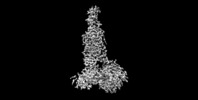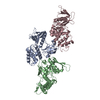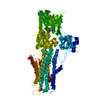登録情報 データベース : EMDB / ID : EMD-23274タイトル PF 06882961 bound to the glucagon-like peptide-1 receptor (GLP-1R):Gs complex main map, consensus refinement, post-processed 複合体 : GLP-1:Gs complex with small molecule agonist bound (PF-06882961)タンパク質・ペプチド : Glucagon-like peptide 1 receptorタンパク質・ペプチド : Guanine nucleotide-binding protein G(s) subunit alpha isoforms shortタンパク質・ペプチド : Guanine nucleotide-binding protein G(I)/G(S)/G(T) subunit beta-1タンパク質・ペプチド : Guanine nucleotide-binding protein G(I)/G(S)/G(O) subunit gamma-2リガンド : 2-[(4-{6-[(4-cyano-2-fluorophenyl)methoxy]pyridin-2-yl}piperidin-1-yl)methyl]-1-{[(2S)-oxetan-2-yl]methyl}-1H-benzimidazole-6-carboxylic acidリガンド : water機能・相同性 分子機能 ドメイン・相同性 構成要素
/ / / / / / / / / / / / / / / / / / / / / / / / / / / / / / / / / / / / / / / / / / / / / / / / / / / / / / / / / / / / / / / / / / / / / / / / / / / / / / / / / / / / / / / / / / / / / / / / / / / / / / / / / / / / / / / / / / / / / / / / / / / / / / / / / / / / / / / / / / / / / / / / / / / / / / / / / / / / / / 生物種 Homo sapiens (ヒト)手法 / / 解像度 : 2.9 Å Belousoff MJ / Johnson RM / Drulyte I / Yu L / Kotecha A / Danev R / Wootten D / Zhang X / Sexton PM 資金援助 Organization Grant number 国 Australian Research Council (ARC) IC200100052 National Health and Medical Research Council (NHMRC, Australia) 1126857 National Health and Medical Research Council (NHMRC, Australia) 1184726 National Health and Medical Research Council (NHMRC, Australia) 1150083 Japan Science and Technology 18069571
ジャーナル : Structure / 年 : 2021タイトル : Evolving cryo-EM structural approaches for GPCR drug discovery.著者 : Xin Zhang / Rachel M Johnson / Ieva Drulyte / Lingbo Yu / Abhay Kotecha / Radostin Danev / Denise Wootten / Patrick M Sexton / Matthew J Belousoff / 要旨 : G protein-coupled receptors (GPCRs) are the largest class of cell surface drug targets. Advances in stabilization of GPCR:transducer complexes, together with improvements in cryoelectron microscopy ... G protein-coupled receptors (GPCRs) are the largest class of cell surface drug targets. Advances in stabilization of GPCR:transducer complexes, together with improvements in cryoelectron microscopy (cryo-EM) have recently been applied to structure-assisted drug design for GPCR agonists. Nonetheless, limitations in the commercial application of these approaches, including the use of nanobody 35 (Nb35) to aid complex stabilization and the high cost of 300 kV imaging, have restricted broad application of cryo-EM in drug discovery. Here, using the PF 06882961-bound GLP-1R as exemplar, we validated the formation of stable complexes with a modified Gs protein in the absence of Nb35. In parallel, we compare 200 versus 300 kV image acquisition using a Falcon 4 or K3 direct electron detector. Moreover, the 200 kV Glacios-Falcon 4 yielded a 3.2 Å map with clear density for bound drug and multiple structurally ordered waters. Our work paves the way for broader commercial application of cryo-EM for GPCR drug discovery. 履歴 登録 2021年1月11日 - ヘッダ(付随情報) 公開 2021年1月20日 - マップ公開 2021年1月20日 - 更新 2021年9月15日 - 現状 2021年9月15日 処理サイト : RCSB / 状態 : 公開
すべて表示 表示を減らす
 データを開く
データを開く 基本情報
基本情報 マップデータ
マップデータ 試料
試料 機能・相同性情報
機能・相同性情報 Homo sapiens (ヒト)
Homo sapiens (ヒト) データ登録者
データ登録者 オーストラリア,
オーストラリア,  日本, 5件
日本, 5件  引用
引用 ジャーナル: Structure / 年: 2021
ジャーナル: Structure / 年: 2021


 構造の表示
構造の表示 ムービービューア
ムービービューア SurfView
SurfView Molmil
Molmil Jmol/JSmol
Jmol/JSmol ダウンロードとリンク
ダウンロードとリンク emd_23274.map.gz
emd_23274.map.gz EMDBマップデータ形式
EMDBマップデータ形式 emd-23274-v30.xml
emd-23274-v30.xml emd-23274.xml
emd-23274.xml EMDBヘッダ
EMDBヘッダ emd_23274_fsc.xml
emd_23274_fsc.xml FSCデータファイル
FSCデータファイル emd_23274.png
emd_23274.png emd_23274_additional_1.map.gz
emd_23274_additional_1.map.gz emd_23274_additional_2.map.gz
emd_23274_additional_2.map.gz emd_23274_additional_3.map.gz
emd_23274_additional_3.map.gz emd_23274_half_map_1.map.gz
emd_23274_half_map_1.map.gz emd_23274_half_map_2.map.gz
emd_23274_half_map_2.map.gz http://ftp.pdbj.org/pub/emdb/structures/EMD-23274
http://ftp.pdbj.org/pub/emdb/structures/EMD-23274 ftp://ftp.pdbj.org/pub/emdb/structures/EMD-23274
ftp://ftp.pdbj.org/pub/emdb/structures/EMD-23274 emd_23274_validation.pdf.gz
emd_23274_validation.pdf.gz EMDB検証レポート
EMDB検証レポート emd_23274_full_validation.pdf.gz
emd_23274_full_validation.pdf.gz emd_23274_validation.xml.gz
emd_23274_validation.xml.gz emd_23274_validation.cif.gz
emd_23274_validation.cif.gz https://ftp.pdbj.org/pub/emdb/validation_reports/EMD-23274
https://ftp.pdbj.org/pub/emdb/validation_reports/EMD-23274 ftp://ftp.pdbj.org/pub/emdb/validation_reports/EMD-23274
ftp://ftp.pdbj.org/pub/emdb/validation_reports/EMD-23274 リンク
リンク EMDB (EBI/PDBe) /
EMDB (EBI/PDBe) /  EMDataResource
EMDataResource マップ
マップ ダウンロード / ファイル: emd_23274.map.gz / 形式: CCP4 / 大きさ: 91.1 MB / タイプ: IMAGE STORED AS FLOATING POINT NUMBER (4 BYTES)
ダウンロード / ファイル: emd_23274.map.gz / 形式: CCP4 / 大きさ: 91.1 MB / タイプ: IMAGE STORED AS FLOATING POINT NUMBER (4 BYTES) 試料の構成要素
試料の構成要素 Homo sapiens (ヒト)
Homo sapiens (ヒト) Trichoplusia ni (イラクサキンウワバ)
Trichoplusia ni (イラクサキンウワバ) Homo sapiens (ヒト)
Homo sapiens (ヒト) Trichoplusia ni (イラクサキンウワバ)
Trichoplusia ni (イラクサキンウワバ) Homo sapiens (ヒト)
Homo sapiens (ヒト) Trichoplusia ni (イラクサキンウワバ)
Trichoplusia ni (イラクサキンウワバ) Homo sapiens (ヒト)
Homo sapiens (ヒト) Trichoplusia ni (イラクサキンウワバ)
Trichoplusia ni (イラクサキンウワバ) Homo sapiens (ヒト)
Homo sapiens (ヒト) Trichoplusia ni (イラクサキンウワバ)
Trichoplusia ni (イラクサキンウワバ)

 解析
解析 試料調製
試料調製 電子顕微鏡法
電子顕微鏡法 FIELD EMISSION GUN
FIELD EMISSION GUN
 ムービー
ムービー コントローラー
コントローラー




































 Z
Z Y
Y X
X










































